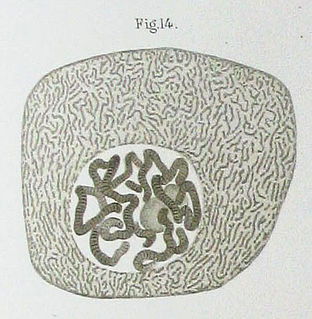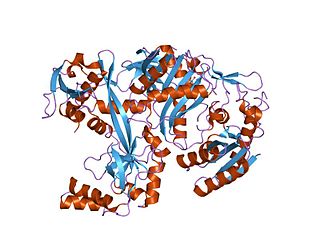
Drosophila is a genus of flies, belonging to the family Drosophilidae, whose members are often called "small fruit flies" or pomace flies, vinegar flies, or wine flies, a reference to the characteristic of many species to linger around overripe or rotting fruit. They should not be confused with the Tephritidae, a related family, which are also called fruit flies ; tephritids feed primarily on unripe or ripe fruit, with many species being regarded as destructive agricultural pests, especially the Mediterranean fruit fly.

In biology, a mutation is an alteration in the nucleotide sequence of the genome of an organism, virus, or extrachromosomal DNA. Viral genomes contain either DNA or RNA. Mutations result from errors during DNA or viral replication, mitosis, or meiosis or other types of damage to DNA, which then may undergo error-prone repair, cause an error during other forms of repair, or cause an error during replication. Mutations may also result from insertion or deletion of segments of DNA due to mobile genetic elements.

A transposable element is a DNA sequence that can change its position within a genome, sometimes creating or reversing mutations and altering the cell's genetic identity and genome size. Transposition often results in duplication of the same genetic material. Barbara McClintock's discovery of them earned her a Nobel Prize in 1983.
Selfish genetic elements are genetic segments that can enhance their own transmission at the expense of other genes in the genome, even if this has no positive or a net negative effect on organismal fitness. Genomes have traditionally been viewed as cohesive units, with genes acting together to improve the fitness of the organism. However, when genes have some control over their own transmission, the rules can change, and so just like all social groups, genomes are vulnerable to selfish behaviour by their parts.

Drosophila melanogaster is a species of fly in the family Drosophilidae. The species is often referred to as the fruit fly or lesser fruit fly, however its common name is more accurately the vinegar fly. Starting with Charles W. Woodworth's proposal of the use of this species as a model organism, D. melanogaster continues to be widely used for biological research in genetics, physiology, microbial pathogenesis, and life history evolution. As of 2017, five Nobel Prizes have been awarded to [drosophilists] for their work using the animal.
In cell biology, a granule is a small particle. It can be any structure barely visible by light microscopy. The term is most often used to describe a secretory vesicle.

Polytene chromosomes are large chromosomes which have thousands of DNA strands. They provide a high level of function in certain tissues such as salivary glands of insects
Meiotic drive is a type of intragenomic conflict, whereby one or more loci within a genome will effect a manipulation of the meiotic process in such a way as to favor the transmission of one or more alleles over another, regardless of its phenotypic expression. More simply, meiotic drive is when one copy of a gene is passed on to offspring more than the expected 50% of the time. According to Buckler et al., "Meiotic drive is the subversion of meiosis so that particular genes are preferentially transmitted to the progeny. Meiotic drive generally causes the preferential segregation of small regions of the genome".
Balancer chromosomes are a type of genetically engineered chromosome used in laboratory biology for the maintenance of recessive lethal mutations within living organisms without interference from natural selection. Since such mutations are viable only in heterozygotes, they cannot be stably maintained through successive generations and therefore continually lead to production of wild-type organisms, which can be prevented by replacing the homologous wild-type chromosome with a balancer. In this capacity, balancers are crucial for genetics research on model organisms such as Drosophila melanogaster, the common fruit fly, for which stocks cannot be archived. They can also be used in forward genetics screens to specifically identify recessive lethal mutations. For that reason, balancers are also used in other model organisms, most notably the nematode worm Caenorhabditis elegans and the mouse.
Piwi-interacting RNA (piRNA) is the largest class of small non-coding RNA molecules expressed in animal cells. piRNAs form RNA-protein complexes through interactions with piwi-subfamily Argonaute proteins. These piRNA complexes are mostly involved in the epigenetic and post-transcriptional silencing of transposable elements and other spurious or repeat-derived transcripts, but can also be involved in the regulation of other genetic elements in germ line cells.

Piwi genes were identified as regulatory proteins responsible for stem cell and germ cell differentiation. Piwi is an abbreviation of P-elementInduced WImpy testis in Drosophila. Piwi proteins are highly conserved RNA-binding proteins and are present in both plants and animals. Piwi proteins belong to the Argonaute/Piwi family and have been classified as nuclear proteins. Studies on Drosophila have also indicated that Piwi proteins have slicer activity conferred by the presence of the Piwi domain. In addition, Piwi associates with heterochromatin protein 1, an epigenetic modifier, and piRNA-complementary sequences. These are indications of the role Piwi plays in epigenetic regulation. Piwi proteins are also thought to control the biogenesis of piRNA as many Piwi-like proteins contain slicer activity which would allow Piwi proteins to process precursor piRNA into mature piRNA.
Drosophila X virus (DXV) belongs to the Birnaviridae family of viruses. Birnaviridae currently consists of three genera. The first genus is Entomobirnavirus, which contains DXV. The next genus is Aquabirnavirus, containing infectious pancreatic necrosis virus (IPNV). The last genus is Avibirnavirus, which contains infectious bursal disease virus (IBDV). All of these genera contain homology in three specific areas of their transcripts. The homology comes from the amino and carboxyl regions of preVP2, a small 21-residue-long domain near the carboxyl terminal of VP3, and similar small ORFs sequences.
Maternal effect dominant embryonic arrest (Medea) is a selfish gene composed of a toxin and an antidote. A mother carrying Medea will express the toxin in her germline, killing her progeny. If the children also carry Medea, they produce copies of the antidote, saving their lives. Therefore, if a mother has one Medea allele and one non-Medea allele, half of her children will inherit Medea and survive while the other half will inherit the non-Medea allele and die.

In molecular biology, heat shock factors (HSF), are the transcription factors that regulate the expression of the heat shock proteins. A typical example is the heat shock factor of Drosophila melanogaster.
Vasa is an RNA binding protein with an ATP-dependent RNA helicase that is a member of the DEAD box family of proteins. The vasa gene, is essential for germ cell development and was first identified in Drosophila melanogaster, but has since been found to be conserved in a variety of vertebrates and invertebrates including humans. The Vasa protein is found primarily in germ cells in embryos and adults, where it is involved in germ cell determination and function, as well as in multipotent stem cells, where its exact function is unknown.
Transposon silencing is a form of transcriptional gene silencing targeting transposons. Transcriptional gene silencing is a product of histone modifications that prevent the transcription of a particular area of DNA. Transcriptional silencing of transposons is crucial to the maintenance of a genome. The “jumping” of transposons generates genomic instability and can cause extremely deleterious mutations. Transposable element insertions have been linked to many diseases including hemophilia, severe combined immunodeficiency, and predisposition to cancer. The silencing of transposons is therefore extremely critical in the germline in order to stop transposon mutations from developing and being passed on to the next generation. Additionally, these epigenetic defenses against transposons can be heritable. Studies in Drosophila, Arabidopsis thaliana, and mice all indicate that small interfering RNAs are responsible for transposon silencing. In animals, these siRNAS and piRNAs are most active in the gonads.
The gene Maelstrom, Mael, creates a protein, which was first located in Drosophila melanogaster in the nuage perinuclear structure and has functionality analogous to the spindle, spn, gene class. Its mamallian homolog is MAEL.

Transposable elements are pieces of genetic material that are capable of splicing themselves into a host genome and then self propagating throughout the genome, much like a virus. Retrotransposons are a subset of transposable elements that use an RNA intermediate and reverse transcribe themselves into the genome. Retrotransposon proliferation may lead to insertional mutagenesis, disrupt the process of DNA repair, or cause errors during chromosomal crossover, and so it is advantageous for an organism to possess the means to suppress or "silence" retrotransposon activity.

The fusome is a membranous structure found in the developing germ cell cysts of many insect orders. Initial description of the fusome occurred in the 19th century and since then the fusome has been extensively studied in Drosophila melanogaster male and female germline development. This structure has roles in maintaining germline cysts, coordinating the number of mitotic divisions prior to meiosis, and oocyte determination by serving as a structure for intercellular communication.
Anthony Mahowald is a molecular genetics and cellular biologist who served as the department chair of the molecular genetics and cellular biology department at the University of Chicago. His lab focused on the Drosophila melanogaster, which is often referred to as fruit fly, specifically focusing on controlling the genetic aspect of major developmental events. His major research breakthroughs included the study of the stem cell niche, endocycles, and various types of actin.








